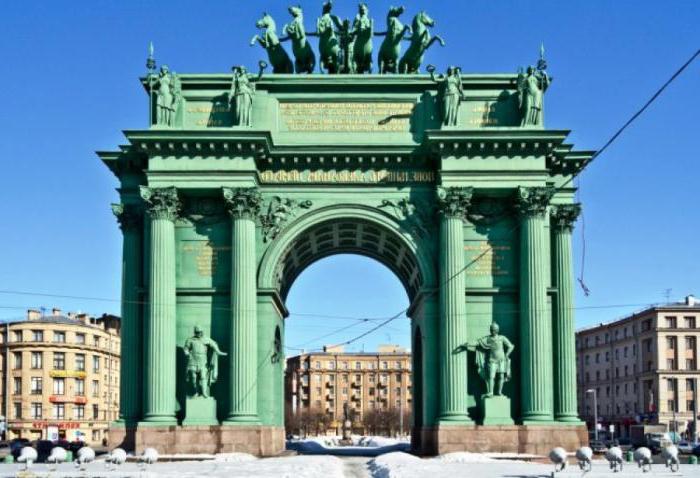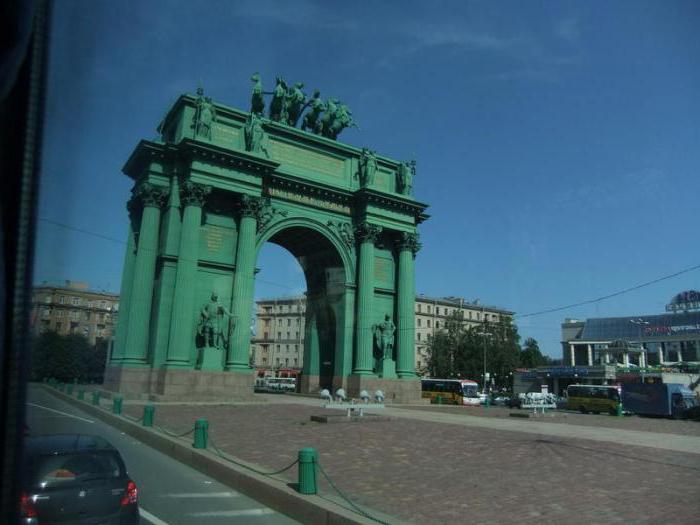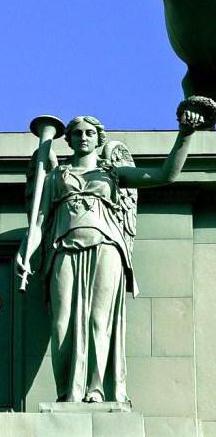Narva Triumphal Gates (St. Petersburg): History, Description
The great national victories always found a response inarchitectural buildings - unique and unique. One of the incarnations of gratitude to the descendants of the victorious warriors in the Patriotic War of 1812 was the Narva Triumphal Gates, erected for the return of the army from defeated France.

Narva triumphal gates in St. Petersburg: history
For the first time the idea of creating a monument arose 14April 1814, after the news of the return of Russian heroes from Paris. This message put an end to the victorious conclusion of the war with Napoleon. The city was preparing to solemnly meet the winners, and on the initiative of General SK Vyazmitinov, at an urgently convened meeting of the Senate, the installation of an arched gate was approved on the way that guards troops would arrive in St. Petersburg.
The triumphal arch was designed by architectStasov VP - academician of architecture of the Imperial Academy of Arts. But since there was not much time left, we decided to modify the entrance gates of Kalinkin Bridge by reconstructing them and decorating them with a sculptural decoration. Reconstruction was entrusted to Quarenghi D. - a brilliant Italian architect, who had the courage to disobey the King of Italy and stay in Russia in a difficult for her military period.

The pylons of the arch placed the names of all the warriorsGuards regiments, and a wide attic decorated with a grateful inscription in Latin and Russian. On both sides of the arch, spectators' stands were built. For the imperial family erected special galleries.

Entry of troops into the city
By July 30, 1814 the structure was built. The Narva triumphal gates met the winners. On this day, under the arch with triumph, the Guards infantrymen of the Preobrazhensky, Izmailovsky, Semyonovsky and Jaeger regiments marched.
On September 6, the town was met by the Finnish and Pavlovsky Life Guards Regiments, on October 18 the cavalry guards arrived, and on October 25 - the Cossack Regiment.
New gates
After 10 years, the design has become noticeably dilapidated, andIt was decided to demolish it, which was adopted by the relevant resolution. Genaral Governor Miloradovich MA has obtained the highest permission for the erection of the marble triumphal arch, "in order to commemorate the memory of the thankful". New Narva triumphal gates were planned to be created at a small distance from the bridge (across the Tarakanovka river along the Peterhof road). The construction committee, led by Miloradovich, included the president of the art academy, Olenin AN, who proposed to preserve the main motif of the Quarenghi arch in the future building. Sculptor of the Narva triumphal gates Stasov followed the advice, having embodied in the project the wishes of Olenin, only increasing the size of the monument and changing the decor elements.

The date of commencement of construction is August 5, 1827. On this day, we began the construction of a pit for the foundation of future gates. And on August 26, on the anniversary of the Battle of Borodino, the monument of triumph was laid. Nearly 9,000 veterans attended the ceremony.
Ceremony of bookmarking the gate
The beginning of construction was marked by a visitmembers of the royal family. Eleven stones were engraved with the engraving of the royal names and the architect's name, gold coins, guards awards and a commemorative plaque. The ceremony ended with a solemn march of guardsmen.
Stages of construction
In the autumn of 1827 More than 1000 piles were piled into the foundation pit, the length of each of them exceeded 8 m, and the diameter was 0.5 m. The intervals between the piles were filled with stone slabs, and three more layers were laid on top: 0.5 m of granite, 1.5 m of Tosnensky slabs and 0.5 m of granite. The completed foundation was waiting for the continuation of the work for three years because of the disagreements over the material from which the gates would be built.
In 1830, they came to the decision to build a structurefrom a brick with a copper facing, and in August the erection continued. At the same time, the demolition of the former monument, erected by the architect Quarenghi, ended.
Over 2,600 people worked on the monument,was laid half a million bricks. Since 1831, at the foundry of Alexandrovskoye, the manufacture of facing copper sheets began, the thickness of which was 5 mm. At the same plant, all the sculptures and relief inscriptions were made.

The Narva triumphal gates were erected quickly. In the beginning of autumn the brickwork was finished. The fire that occurred in January 1832, when all the protective boardwalks over the arch and service rooms were burned, markedly slowed down the rate of erection, but dried the masonry well. By the spring of the same year, all the consequences of the fire were liquidated, and the work resumed, and on September 26, 1833 the construction was completed.
Parameters of the monument
The Admissions Committee enthusiastically spoke aboutquality of the erected monument, its beauty and architectural ease. Dimensions of the monument are very impressive: the height of the gate was 23 m, and including the Victory sculpture - 30 m. The height of the arch arch is 15 m, the arched width reaches 8 m. The width of the structure is 28 m. The monument is decorated with 12 columns of 10-meter height, almost 1 m.
In each pylon of the structure there are very impressive internal spaces, consisting of 3 floors and a cellar, connected by a spiral staircase.
Today the Narva Triumphal Gates is a museum of the history of their creation, located in these premises.

Sculptural compositions and decor
The beauty and grace of the monument, despite itsmonumentality, amaze. The sculptural ensemble is crowned with the most talented masters of its time: the six horses - Klodt PK, the figure of Victory - Pimenov S., the chariot - Demut-Malinovsky VI. The sculptural group represents a light wagon controlled by the goddess of victory of Nick with a palm branch and a laurel wreath in his hands, symbolizing the glory of the world.
Niche pylons adorn the figures of Old Russianwarriors-heroes in clothes, made according to original samples. On the eaves of the gate are winged female figures - the personification of glory, victory and peace. Immortalized and the names of the Guards regiments - participants in the battles in the war of 1812. On the western facade gold letters indicate the names of the cavalry units, on the eastern side - the infantry. On the edge of the pediment, the main battles are listed.
Emphasizing the dominant position of the monument,the area around it is gradually decreasing. Therefore, the Narva triumphal gates, in which the architect and sculptor sought such an effect, occupy the leading position in the future.
Opening of the monument
On the day of the 21st anniversary of the Kulm Battle, on August 17, 1834, a solemn opening of the monument took place. Under the arch, marched all the Guards regiments, whose names are listed on the gable of the gate.






